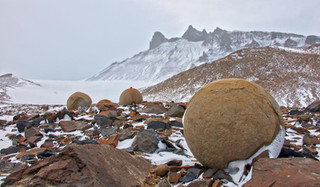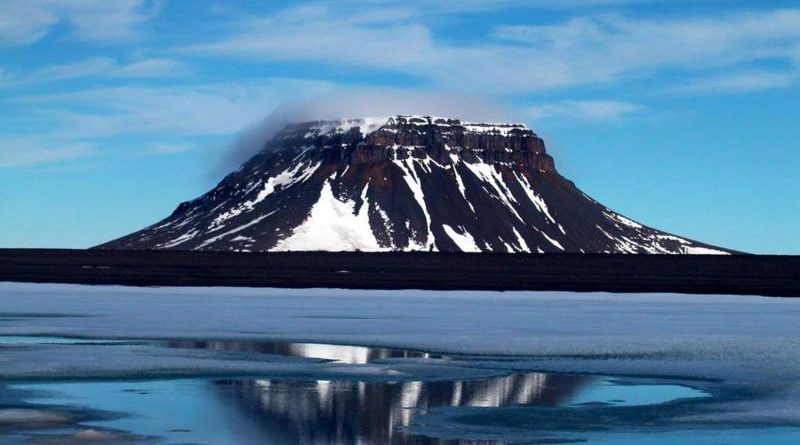Franz Josef Land, jewel to the world a few have seen
Nowhere in the Arctic is the bravery of early polar exploration more plainly obvious than in Franz Josef Land. This 191-island archipelago is notoriously isolated, but a small cruise ship with a fleet of Zodiacs allows visitors to discover the islands’ hidden treasures, such as historical remains of well-known expeditions, dramatic mountains and surreal geology. Located in the most northerly group of islands associated with Eurasia, the archipelago is stretching from west to east 375 km and from north to south 234 km and only 900 to 1110 km from the North Pole, closer than all land masses except for Canada’s Ellesmere Island and Greenland. It is interesting to note that 71% of the total islands occupy only 0.4% of its area. Only 4 of the islands (George Land, Wilczek Land, Graham Bell Island and Alexandra Land) have areas exceeding 100,000 hectares.

Franz Josef Land is dominated by glaciations, which covers 85% of the islands. It is the biggest frozen area of land in the Russian Arctic with immense tidewater glaciers and glittering icebergs provide a stunning backdrop. For the few visitors who make the voyage to these enigmatic islands, the sense of seclusion in place and time is an unquestionable attraction. Even more compelling is the abundance of flora and fauna: this polar wilderness is part of the Russian Arctic National Park since 2012. It is a nature sanctuary home to polar bears and other quintessential High Arctic wildlife—such as walruses, seabird colonies, and some rare whale species like the elusive bow-head whale. Polar bears can be spotted anytime, anywhere in and around Franz Josef Land. Scree slopes and cliffs around the islands host enormous nesting colonies of seabirds. The opportunity to walk in the footsteps of famous polar explorers at well-preserved historical sites is also offered here. The journals of explorers such as Julius von Payer, Benjamin Leigh Smith, Frederick George Jackson, and Fridtjof Nansen come alive at Cape Norway, Cape Flora, Eira Harbour, and Cape Tegetthoff. Memorials, monuments, crosses and the remains of dwellings are testimony to incredible historical events.

Cruise travel to Franz Josef Land is very limited as the archipelago has no infrastructure to support it and these islands can only be reached by an icebreaker ship and therefore a very unique destination few people will ever visit. Typically, these Arctic cruises are operated with departures from Murmansk. The most common is the 3-week North Pole cruise itinerary offered by the Russian nuclear-powered icebreaker 50 Let Pobedy stopping here en-route. During an expedition cruise to Franz Josef Land the vessel will sail along the many islands and go ashore when weather and sea conditions are favorable. Despite the truly harsh climate the nature of Franz Josef Land is unique in its own way. Even in the middle of Summer Sea ice can make exploring parts of Franz Josef Land impossible, and in winter the archipelago is totally surrounded by ice. At times the temperature reaches lower than -40C and in winter total darkness engulfs the island for several months. During the summer period when the expeditions run, the temperature averages a mild couple of degrees above 0C.
Even with the increased interest in the polar regions (40,000+ visitors to Antarctica each year), Franz Josef Land has remained largely unexplored with roughly only 1000 visitors every year. This means that the cruises that visit now may still land at completely new landing sites that have no record of being explored in the past. Some of the places where visitors may explore include:
Bell and Mabel Island
The remains of an empty cabin built in 1880 by British explorer Benjamin Leigh Smith can be found on Bell Island. On Mabel island offers an opportunity to get close to a little auk colony as the birds nest between the rocks on the slope above the beach where the Zodiacs land.

Cape Flora – Northbrook Island
Located in an unglaciated area in the Southwest of Northbrook Island, Cape Flora is one of the most famous historical sites in Franz Josef Land because it is one of the most accessible locations in the archipelago. Cape Flora features some of the most beautiful tundra in Franz Josef Land, but landings on the rocky beach, which is prone to swell from the Barents Sea can often, be tricky. Cape Flora is where Benjamin Leigh Smith’s vessel Eira was shipwrecked in 1881, after being trapped in pack ice.
Geographers Bay (Prince George Land)
Prince George is the largest and longest island of the Franz Josef Archipelago. Most of the island is covered in large glaciers and ice domes, such as the Brusilov Ice Dome – the highest point of the island. A landing at Geographers Bay allows for a hike up one of the ice domes to enjoy the wonderful views over the archipelago, as Prince George Island is not fully glaciated. It’s also a great spot for enjoying the typical flowers of the north Arctic tundra.

Rubini Rock (Hooker Island)
The impressive basalt cliffs create the best bird cliffs in the archipelago housing more than 100,000 birds comprising of mostly Brünnich guillemot, but also kittiwake and little auks. The bird cliff lies just off Calm Bay and is perfect for Zodiac cruises. The island is a volcanic plug, the central remains of conical volcano.

Cape Triest, Champ Island
Champ Island is famous for the incredible stone spheres (geodes), commonly called “Devils Marbles” with sizes ranging from tennis balls to boulders that are three meters in diameter. These rocks are a unique geological feature that can be found only in the Arctic regions.
Sarko Passage – Newcombe sound (Nansen archipelago)
Beautifully glaciated landscape featuring an enormous glacier front with a lot of sea Ice. It’s one of the best spots to marvel at glaciers, ice and perhaps polar bears.

Cape Norway (Jackson Island)
The place where the famous Norwegian explorers Fritjoj Nansen and Hjalmar Johansen spent the winter of 1895-96 after returning from their attempt to reach the North Pole. Visitors can see the remains of the stone hut built by the men including a big log that was used as a makeshift roof. A commemorative plaque provides marks this event where the men survived the winter until the following summer, when they resumed their journey southwards.
